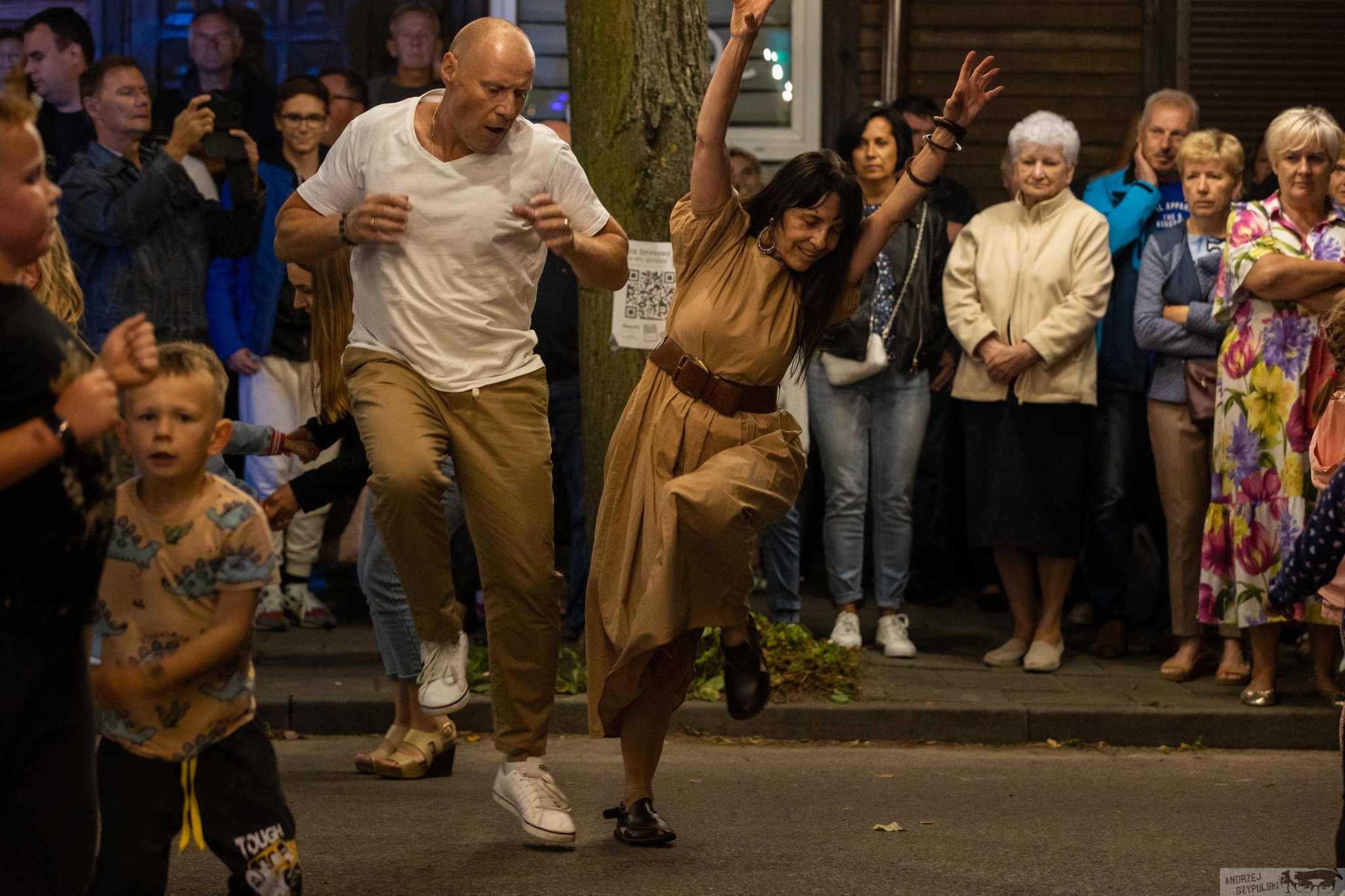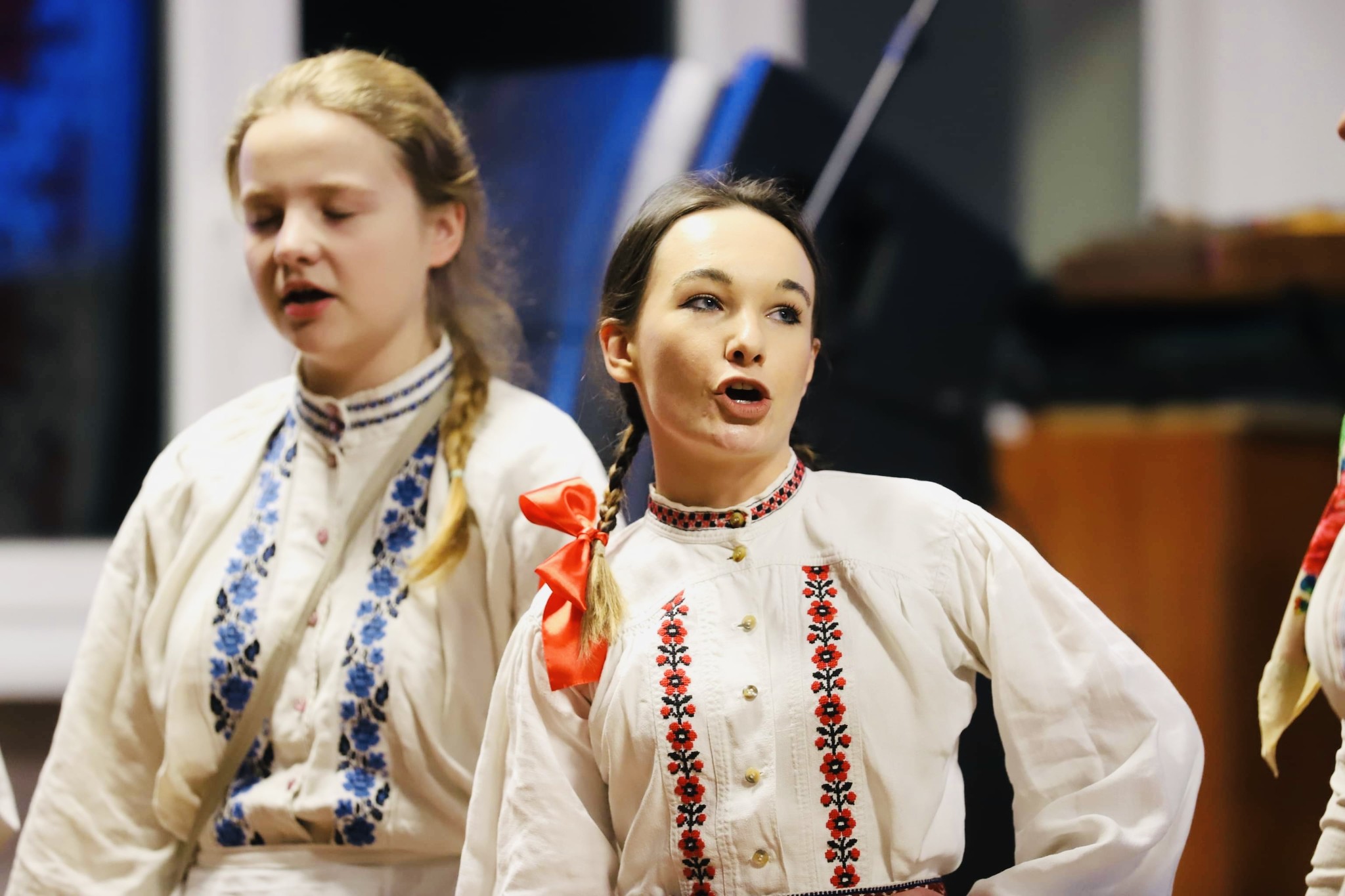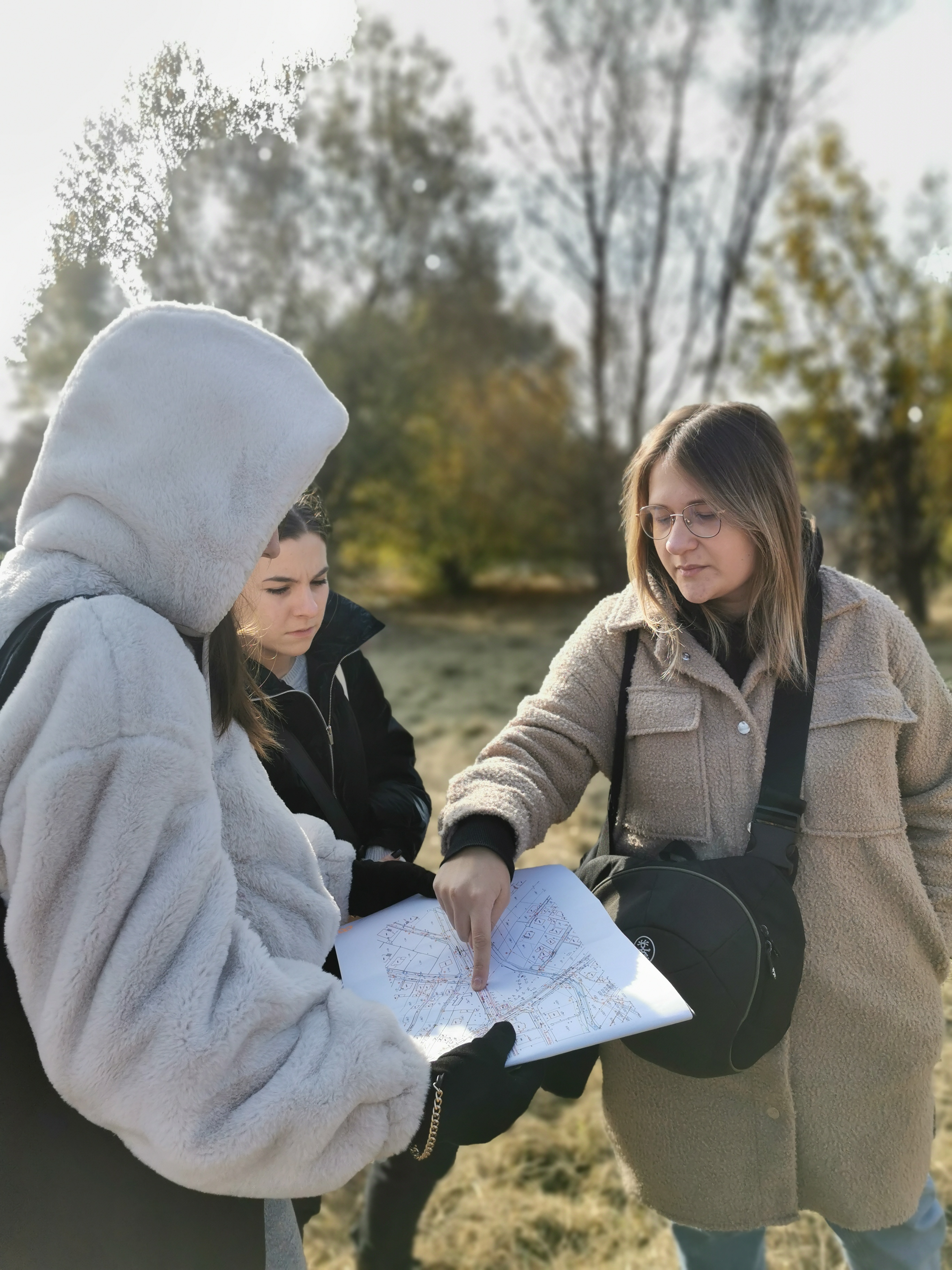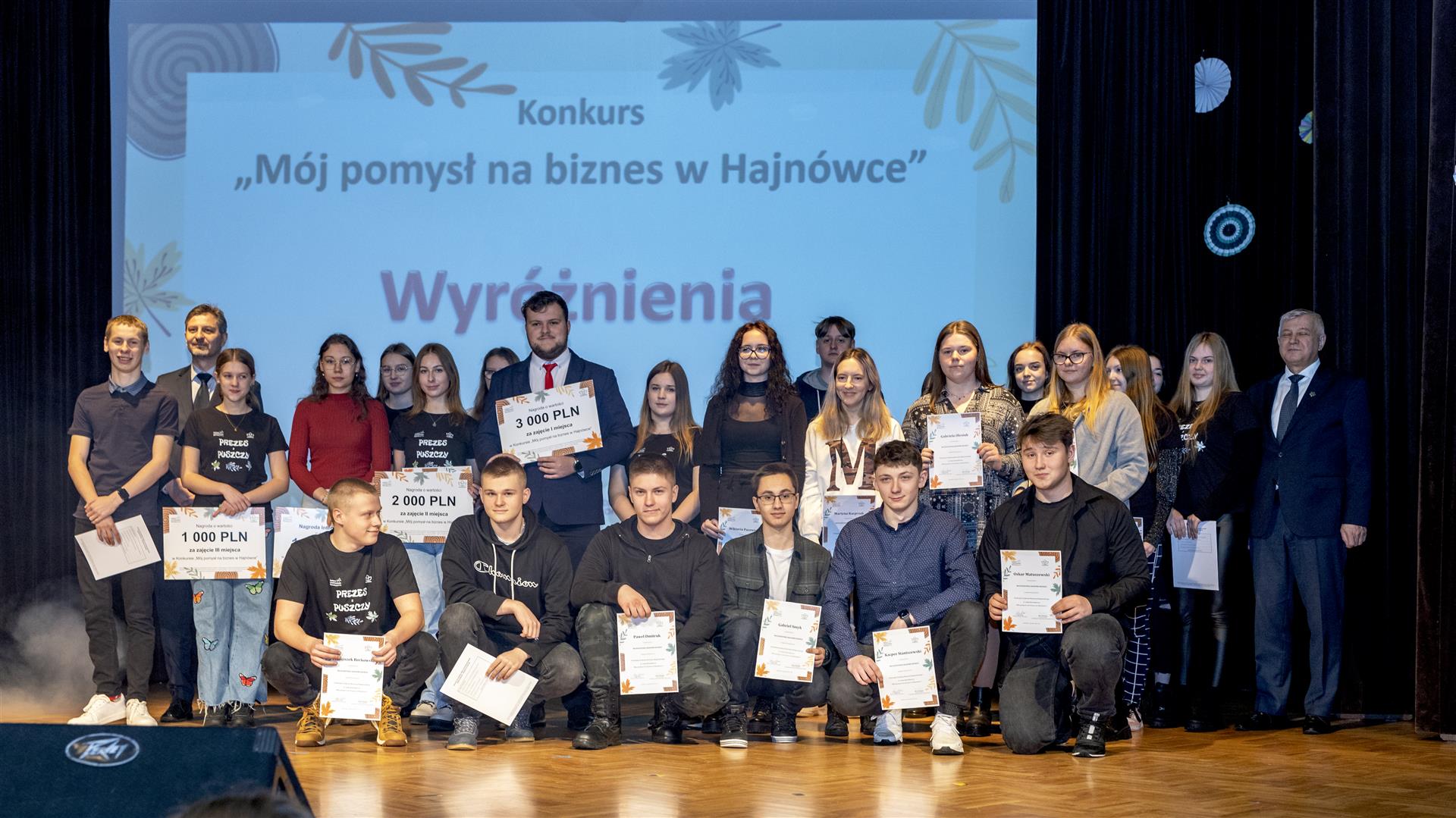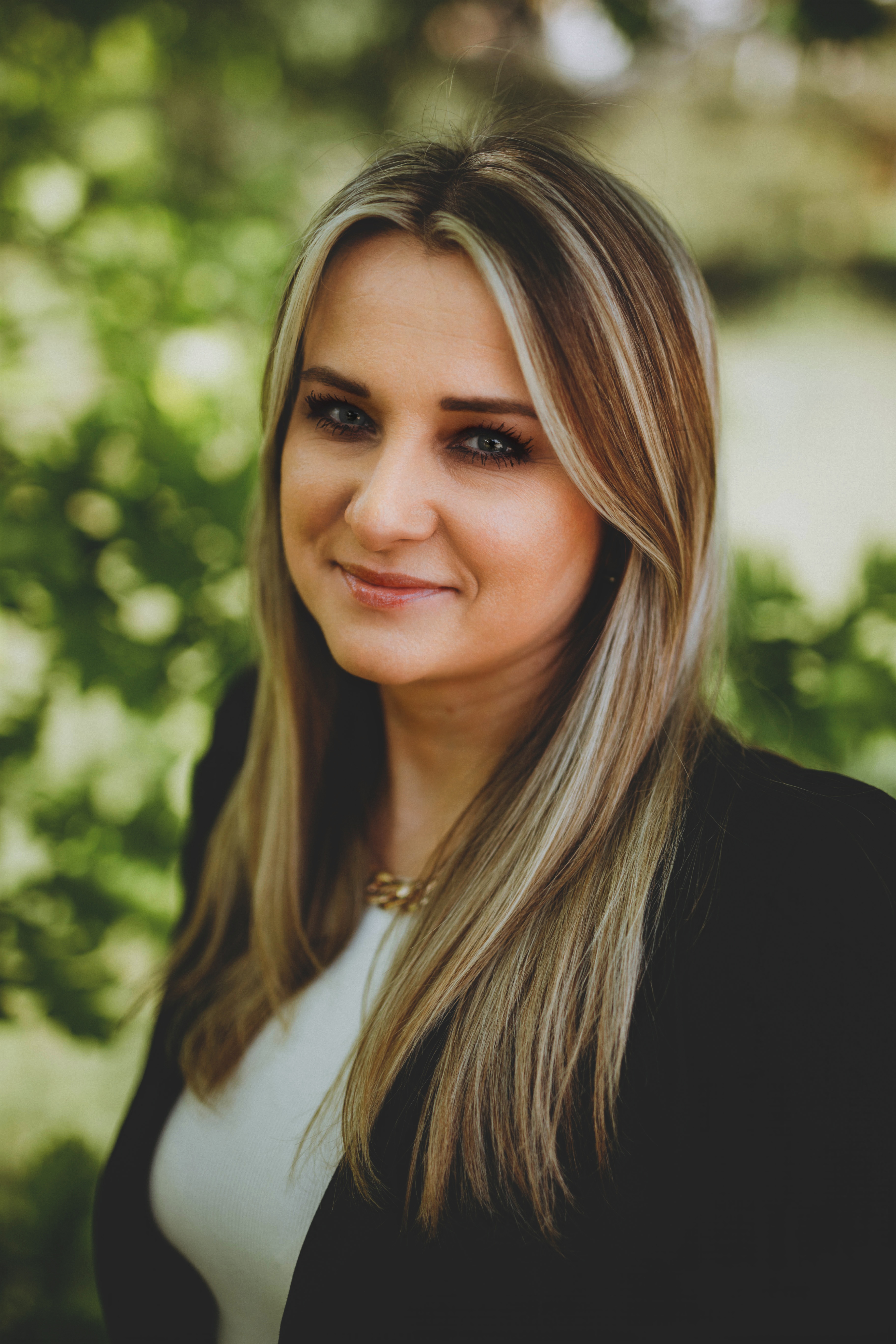For those who aren’t from Hajnówka, this title may be incomprehensible. In the local dialect it means “come on, let’s rock this Hajnówka”. Sit back and read the story of a woman and her team who put their whole heart into the work of officials. Together with the local residents, they are rocking Hajnówka.
"This is a komsekula" , she says and shows me a piece of jewellery.
The pendant is shaped like a ball and has several rings attached.
"The Sámi people see this amulet as a symbol of something new. They use to hung it above the cradle of the new-born. It’s meant to protect and bring good luck. I received it from Heidi with good wishes for our new development policy", she explains.
She later sends me a more extensive explanation from a friend in Norway, from which I learn that a ‘komse’ is a traditional Sámi cradle that parents carry on their back, and ‘kule’ means simply a ball. The peoples living in the northern part of Europe obtained this jewellery by trading with merchants from the south of our continent. In the Middle Ages, komsekula was believed to protect against disease, especially in the 14th century when the plague epidemic reached Europe. In the north, the amulet took on a different meaning. It was hung above the cradle of the new-born to protect the child from being taken away by the dark forces that inhabit the underworld.
I learn all this from Magdalena Chirko, coordinator of the project “Hajnówka Renewal – Green Transformation”, which was co-financed by the EEA and Norway Funds. Ms Magdalena is also the head of the Development Department at the Hajnówka City Hall. She has worked here for 18 years.
She received the amulet from her counterpart in the Norwegian town of Alta, located in the far north of this country. When she talks about this gift, her face shows a smile and, at least that’s what I feel, a hint of affection. Hajnówka is drawing on Alta’s experience in implementing its project. We’ll yet return to the north of Norway. For now, let’s stay in Hajnówka with Magdalena Chirko as our guide.
Reinventing oneself
You hear Hajnówka, you think...well, exactly what? I suspect that the majority of respondents in a TV quiz would mention the Białowieża Forest and the proximity to Belarus. Some would probably add something about the Orthodox church music festival and the timber industry, which used to be a mainstay of the local economy for years. This is all true, but I’d like to know a little more, to scrape off that top layer of most common associations and to get an idea of how this town can develop.
I became interested in Hajnówka when I was looking for inspiration for the next text in the #OurStories series (yes, I do mean the text you’re reading now). A colleague of mine, dealing with the part of the EEA and Norway Funds that are allocated to urban development, suggested me to take a look at the project implemented by this town.
"Listen, Paweł, they’re running it very well. Why don’t you write about them?", he said.
"Well, why not?" - I thought and started looking for information.
Wikipedia, project website, media reports. The deeper I looked, the more I understood why the project is called “Hajnówka Renewal – Green Transformation”. The idea behind the whole project is to make Hajnówka find a new idea for itself, a new way of development. This means a kind of way to curb the negative phenomena that have accumulated in the town, while using its strengths as a springboard for development.
"We assumed that Hajnówka requires a recovery plan from scratch", states Magdalena Chirko firmly.
Having heard that, I already know that this will be an interesting conversation.
Painful diagnosis
There’s no use in hiding that I was a little shocked by the firmness of this statement, even though I already had reason to believe that it might fall. Prior to our conversation, I researched the website that was created for the project. In also includes a lot of explicit statements. Straight to the point. An example? There you go:
"The Białowieża Primeval Forest has not been a source of raw material for a long time, and its resources are strictly protected as a valuable natural area, entered on the UNESCO World Heritage List. Consequently, the character of Hajnówka has also changed. However, its urban character remained the same. As a result, the city is not attractive for residents and visitors. The former, due to the lack of a designated centre and related attractions, are not too attached to the city. In turn, tourists feel lost in an unmarked space without character. Nothing makes them stay here any longer", we read.
That sounds quite painful. The right hook hit the target and there goes the left uppercut.
"The city’s proximity to the Białowieża Forest has made it ‘free’ from taking care of the environment. This resulted in, among other things, unsatisfactory air quality in the city, which has negative impact on the health and living comfort of the residents",” we can read elsewhere on hajnowkaodnowa.pl
There are more such statements there. I ask Magdalena Chirko where does honesty come from. Does she feel sorry when reading such content? After all, local government officials generally praise their cities on their websites.
"We assumed from the very beginning that we were betting on the truth even if it was to be painful. There’s no other way than to beat one’s chest and admit that some things are not right", Magdalena Chirko explains.
I have to admit that I’m impressed by this sincerity. Every therapy has to start with an accurate diagnosis. And in this case some things are indeed going bad. If Hajnówka was a patient in a doctor’s consulting room, it would probably complain that it hurts her everywhere.
A few years ago, the Polish Academy of Sciences prepared a study on Polish medium-sized cities. There are 255 such cities in Poland. Scientists studied them and found that 122 of them are losing their socio-economic functions, which, in other words, means that they’re ‘regressing’ in terms of population, economy and in other spheres. In this ranking, Hajnówka came second, just after Prudnik. However, this is not something to brag about, because a podium in this ranking actually means that things aren’t going well in the given city.
Saw in the coat of arms
"After the collapse of the timber industry, the city had no perspectives for development. There was no idea what to do next", Magdalena Chirko explains.
I look at the city’s coat of arms, read about the history of Hajnówka, and then I’m beginning to understand. Hajnówka is a relatively young city. It received its municipal rights in 1951. Its history and identity are linked to the Białowieża Forest. However, it’s not about blissful relaxation in natural surroundings, but about the timber industry and the felling of the Białowieża Forest and the subsequent processing of wood. The forest was not the queen of Hajnówka, but rather its slave. The city’s coat of arms features trees and a circular saw. That's a pretty eloquent symbol, isn’t it?
Today, Hajnówka no longer enslaves the forest, but faces the typical problems of cities that have been subordinated to one plant or one industry. The most important of these are the exodus of young people and the city’s lack of identity.
"The fact that for so many years the labour market in Hajnówka was dominated by the timber industry, and that after the collapse of this industry no direction of development was invented, affected many areas. Let’s take the entrepreneurship, for example. People experienced job security for years. They got used to the idea that the state would take care of them and so they don’t have to take care of themselves", Magdalena Chirko says.
The exodus of young people who leave Hajnówka for studies, for example in Warsaw or Bialystok, and don’t return is particularly acute. According to a study by the Podlasie Regional Development Foundation, five people leave this region permanently every day. However, in small cities such as Hajnówka, this is particularly evident. In 2020, Hajnówka had a population of 20,265. This means a decrease by 2,090 residents compared to ten years earlier. According to the Local Development Monitor, Hajnówka in 2021 had a population of only 19,487, which moves it into the category of small cities. The number of young people is decreasing, while the number of seniors is increasing. According to forecasts, by around 2040, there will be only one person of working age for every three senior citizens.
Dostoevsky likes this
Now I already know what problems Hajnówka is facing. The most important question remains: what can be done about it?
"Primeval forest is the foundation of Hajnówka’s new development policy", states the project coordinator.
In her view, it can be the basis for various other activities, for example related to tourism, education and entrepreneurship.
I find at the project’s website an interesting, somewhat humorous, but also emphatic statement about how the primeval forest is important for the development of Hajnówka:
"The outline of the city’s administrative borders resembles the head of a bison – the king of the forest. This is of course only a curiosity, but this direction should not be underestimated. The development of the city should run in synergy with the Białowieża Forest", states the website.
"Basing the development on the proximity to the forest by no means preclude production activities. We can bet on a lightweight, environmentally and climate-friendly industry", says Magdalena Chirko.
The primeval forest appears virtually everywhere in the “Hajnówka Renewal Green – Transformation” project. Before we get to the project itself, let’s just make one small annotation.
"I consciously don’t want to call what we’re doing a project, as it would be easy to label our action as easy money or consider it as not relevant to everybody. I prefer to talk about a multi-year programme. We’d like to continue what we have started to do under the EEA and Norway Grants and fund it from other sources in the future", explains Magdalena Chirko.
I’ll nevertheless stick to the word ‘project’, but I understand perfectly well what Ms Magdalena means. This project has so many threads that, if it were literature, we would compare it to a thick novel rather than a short story. At the same time, this novel isn’t a collection of random characters and plots, but a coherent whole written according to the art of novel writing. Dostoevsky, Fleming and King would be proud.
Everything is based on two studies – the Local Development Plan (LDP) and the Institutional Development Plan (IDP). These two documents are obligatory when applying for the EEA and Norway Grants. It’s in these plans that the diagnosis and proposal for a new development path for Hajnówka can be found. Their preparation and in the implementation of the project itself involved advisors from the Association of Polish Cities.
"The collaboration is going great. We very much agreed with the advisors on observations, recommendations and courses of action. Working together even turned into a kind of friendship", says the project coordinator.
In her opinion:
"it’s a very difficult and complex project, the effects of which aren’t immediately visible, as in the case of, for example, road construction projects"
"Some would say: that’s a pity. However, most road projects don’t generate real development on their own. For Hajnówka, roads are definitely not enough. In our case, we’ll have to wait longer for results: a minimum of 10 years; that’s longer than one term of a self-government officials; our initiatives require intervention in many areas. This translates into difficulty and complexity of the project, and sometimes even its misunderstanding", Magdalena Chirko emphasises.
Both plans: the LDP and the IDP form the strategic layer of the project. There’s also an operational layer, i.e. around 100 initiatives such as the Academy of Nature, the Local Product Centre, Local Activity Places and many, many more. These can all be organised under the four directions of development of Hajnówka.
The New Centre of Hajnówka
First of them is the New Centre of Hajnówka.
"Hajnówka has no real city-centre. This results from the industrial history of this place. The urban development of the city was based on the wood processing plants, rather than starting from the centre", explains Magdalena Chirko.
According to people working on the project, the lack of a centre has a negative impact on residents’ attachment to the city and makes it difficult for tourists to get around.
This potential remedy for that is to be the delimitation of the New Centre of Hajnówka. It’s here that the project’s flagship initiatives, such as the Local Product Centre and the Academy of Nature, are to operate. The city also plans to develop the green areas. Local Activity Places will host social events for every age group. Green spaces will be developed and a mural trail will be created. Wierobieja Street – one of the oldest in Hajnówka – is to regain its historic splendour. Since last year, the street has had its own celebration day. Various cultural events organised by the residents themselves took place there in August. This year, a similar event is planned.
The Academy of Nature is designed to be an important part of the New Centre. It won’t be one site, but a collection of different activities. The Academy’s seat will, of course, be located in the city centre, but elements of the concept also include various workshops, lectures, a living mushroom laboratory where it will be possible to see what mushrooms can be found in the Białowieża Forest and touch them. Let’s add to this something that Magdalena Chirko calls the “forest therapy”, which is based on the health-enhancing qualities of the forest.
"We are assisted by a professional physician in this task", the coordinator points out.
What captivated me about the premise of the New Centre of Hajnówka was the Pompik the Bison Glade. Pompik the Bison was created by Tomasz Samojlik, who is the author and illustrator of books about this friendly animal. On a daily basis, he’s a biologist with a PhD in natural sciences and he works at the Mammal Research Institute of the Polish Academy of Sciences in Białowieża. Pompik the Bison is a true ambassador of the Białowieża Forest. He has his own cardboard game, books, as well as animations and a children’s theatre show that can be seen on TVP ABC or YouTube. In 2020, the regional authorities awarded him the honourable title of Podlasie Brand of the Year. A glade named after him will be designated within the city park and will be a place for fun and education.
Honey, cake and dairy
The second direction of development is business. The city boasts delicious Hajnówka marcinek cake (I tried it, it’s great!), July honey, regional cheeses, including cottage cheese, and butter, all made by the District Dairy Cooperative.
Hajnówka will also see, among other things, the Local Product Centre will be set up in, which will promote local products and brands but also help entrepreneurs, e.g. with a training offer. The Municipal also organises business breakfasts, i.e. meetings with local entrepreneurs. The first such breakfast was held in September 2022.
The city will also adapt the secondary school curriculum, so that young people can find their way in the labour market. Surveys completed by the secondary school students show that so far, they haven’t been sufficiently prepared for the requirements of the modern labour market. Thus, it’s planned to provide business development counselling in schools, modify class profiles to make them more relevant to the needs of the labour market, and turn old industrial halls into modern laboratories and demonstrators.
Green Hajnówka
The third direction is environment and climate. The city announces e.g. green bus stops, green roofs, pocket parks, rain gardens, honey meadows, urban beehives and insect houses.
Interestingly, Hajnówka is working closely with the Białystok University of Technology in this area. Last autumn, students from the Faculty of Architecture carried out a dendrologic inventory, which included counting and listing trees and shrubs. Then, as part of their term paper, they prepared 25 pocket park concepts in different locations.
"We wanted the students to let their imagination run wild, so we didn’t give them any guidelines on what elements should be included in the project", says Magdalena Chirko.
The city then organised a vote in which residents would choose the two best ideas. Professional architects will use them to design pocket parks.
Hajnówka is also betting on renewable energy sources. A class dedicated to renewable energy sources will be created at the Vocational School Complex. There are also several environmental education events planned.
With neighbourhood in mind
"In Hajnówka, human capital is no capital"” – these words were uttered by one of Hajnówka resident during research conducted for the project.
This is another painful finding to add to the diagnosis. People working on the project see these words as a plea for the people of Hajnówka and their skills to be treated as capital that can prove beneficial to the city. That's also how Magdalena Chirko sees it.
"We respect our values and traditions, but we look to the future. We want to use our identity to build the future", she says.
Briefly, it’s about the fourth pillar of the new development path, namely the integration and identity of residents.
These include various events organised for and with local residents, e.g. the Neighbourhood Initiatives, a competition organised by the city. Residents propose various initiatives and then the city subsidises them. The selection, however, isn’t decided by the officials themselves, but by residents in an on-line vote. The new winners of this competition will soon be announced, as voting ended at the end of February. Ideas submitted by the residents for this year’s competition include outdoor event on the New Year’s Eve, a young artists’ festival, an inclusive neighbourhood picnic or a mysterious project called "Rhinoceros in the Forest – Hajnówka alternative music vol. 2" - (rest assured, that’s not a competition for the bison, Błękitny Nosorożec (Blue Rhinoceros) is the name of the longest-running punk rock band in Podlasie).
Another example of works dedicated to the identity of Hajnówka is the Festival of the Dialect of the Borderland. It was carried out in November 2022 by the Rural Housewives’ Club TeraMiśki.
"Witaju, wybaczajte, szto tak puozno zaczynajem, ale mnuho was pryszło i treba było kresioł doneści", that was how Anna Nikitiuk, the festival’s initiator and co-organiser, greeted the festival participants.
The festival was bustling with music, food and, of course, the local dialect. The attendance was so large that there weren’t enough seats.
Involving the residents
I ask Magdalena Chirko where the ideas for all these activities come from. It seems obvious to me that officials aren’t making this up all by themselves. The answer to this question leads us to an interesting discussion about public participation, i.e. the participation of residents in the management of the city and in the project itself.
"We involve residents wherever it’s possible. We meet with them, we talk to them. When preparing the project, we conducted dozens of individual in-depth interviews with residents. It’s more labour- and time-consuming than group surveys, but the results are much better. Most of the initiatives implemented within the project are the result of these interviews and conversations" ,” says Magdalena Chirko.
She adds that for her, as a resident and as an official, many of these conversations were simply painful.
Magdalena Chirko emphasises that during the work on the project, she saw emerging a group of people who are very active, involved in various initiatives and devote their private time for these activities.
"We used to call them playfully the “35+ and -55” group. They are active in various organisations, foundations, associations. They know how to organise themselves quickly, e.g. they sewed masks during the pandemic or organised a collection for a child suffering from SMA. This group is very important for our project. It's a strength coming from the community", explains Magdalena Chirko.
There’s one more finding coming out of the conversation about listening to residents. One of the issues that often came up in conversations with residents was the lack of a place for young people to spend their free time.
"We approached schools and youth mentors with this topic. We had meetings with such an attendance that there wasn’t enough space for all the interested participants. Young people told us that they miss having a place where they can relax after lessons, relax, simply sit, talk, play games. Many of the youngsters in our schools come to Hajnówka by bus. What can they do if they have finished classes and have to wait for the bus? We don’t have a typical shopping mall in the city where you could sit and drink a juice. The offer of the community cultural centre can be used only by the participants of specific classes", says Ms Magdalena.
Local Activity Places (LAPs) are supposed to be the answer to these problems. These will be places where not only the young but also the old can spend time safely. Hajnówka is the only city in the province where there is no senior citizens’ club. Magdalena Chirko calls this
"an unlearned lesson from the past"
and points out that
"today, the needs of older people in Hajnówka and their well-being are crucial for the city".
According to the current assumptions, Hajnówka will open one LAP for young people and another one for senior citizens. They are scheduled to be launched in the third quarter of 2023.
Support from the far north
One more important topic emerges in our conversation, when we discuss social participation and the situation of young people in Hajnówka. It’s about drawing on the experience of the city of Alta located in the far north of Norway. Alta is the Norwegian partner for the project. It was from an official of that municipality that Magdalena Chirko received her talisman.
"The issue of young people being left on their own resonated a lot during the preparation of the project. We would like the youngsters to stay in Hajnówka and develop our city, and if they leave to continue education elsewhere, we’d like them to come back one day. The example of Alta made it clear for us that we should focus our activities on young people", says Magdalena Chirko.
Last year a delegation from Hajnówka had the opportunity to see how Alta implements this principle. What attracts young people to Alta and makes them stay there is, among other things, pride of their own identity. Cave drawings dating back more than 6,000 years were found in the not far away from this city. This site was inscribed on the UNESCO World Heritage List in 1985. Today, a museum operates there.
The city and local government have created a rich cultural offer. One of the most popular activities are classes for students who work with flint or learn to prepare Stone Age food. There is a lot going on in Alta. The flagship event is the dog sled races. There are also plenty of concerts. A major role is played by the local Huset Youth House, where young people can develop artistically, search for their passions or simply spent some time in the company of their peers.
Alta in some ways resembles Hajnówka. Both cities have similar populations. Both can boast a place listed as a UNESCO World Heritage Site (in the case of Hajnówka, it’s obviously the Białowieża Forest). What makes the two cities different is migration. Hajnówka’s population is declining, while Alta’s population is increasing.
"Our partners from Alta say they are confident that if they have a good offer for young people, even if these young people don’t stay in the city after high school, they will be back by their thirties. That’s why they approach the young with such sensitivity", Magdalena Chirko points out
Hajnówka models itself on Alta in some of its activities. Above all because Alta has an idea for itself and this idea worked out.
"We’ll incorporate their solutions into our operations", declares Magdalena Chirko.
I asked her how did they actually find Alta and why it was this particular city that became their partner in the project. It turns out that the two cities have much more in common.
"When preparing for the project, we identified several areas, in which we needed a good model to rely on. The Norwegian Association of Local and Regional Authorities proposed Alta as a city that meets our needs. Alta was completely destroyed as declining result of World War II. After 1945, they were building a new city centre, just like we’re about to do now", says Magdalena Chirko.
The example spreads from the top
At the end of the interview, I tell Magdalena Chirko that I hear a note of fatigue in her voice and I ask if she still experiences excitement about her work.
"Of course I do! Change is a difficult process. I’ve heard claims that the project is impossible to implement. I don’t let go so easily. I have by my side a team of people who are truly driven and keep positive attitude. The example spreads from the top. We’d like our team and our office to be a source of inspiration", she responds with enthusiasm.
I can only keep my fingers firmly crossed: for Hajnówka, for the project, for Magdalena Chirko and her team.
The project “Hajnówka Renewal Green Transformation” is implemented by the Municipality of Hajnówka. It has received more than PLN 15 million in funding from the EEA and Norway Grants. Hajnówka is partnered in the project by: Mammal Research Institute of the Polish Academy of Sciences (PAN), Hajnowski poviat, Hajnówka Municipality, Hajnówka Detention Centre, Hajnówka Forest Inspectorate, Białystok University of Technology, Białowieża National Park, Podlaskie Voivodeship.
Author of the text: Paweł Nowak (Communication and Promotion Team, Department of Assistance Programmes of the Ministry of Development Funds and Regional Policy)


